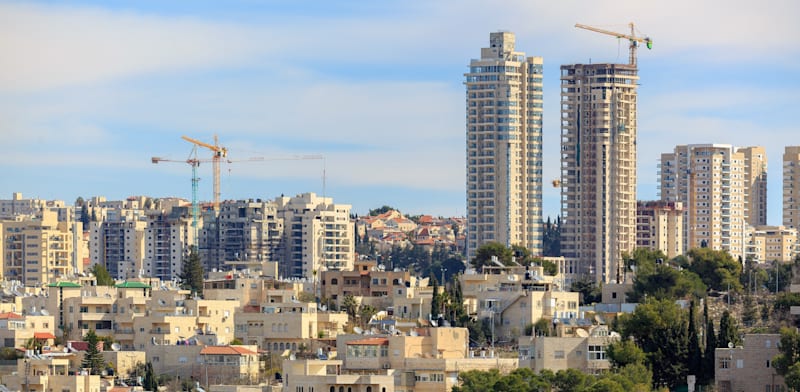The uncertainty surrounding church-owned housing in Jerusalem is not being resolved and has creating a serious real estate market failure in the center of the city. This is the opinion of Hebrew University researchers who examined apartment prices in the area over a 20-year period. The study found that apartment prices on church-owned lands in Jerusalem showed a negative discount of up to 30% compared with other apartments in the area, due to the uncertainty on their future. In the past four years, demand for these properties has fallen by about 20%.
The researchers believe that the situation is encouraging a speculative market, due to the great risks and great profitability inherent in apartments for those who purchase them before an agreement has been reached.
Contracts that will expire by 2150
This new study was presented at a conference of the Alrov Institute for Real Estate Research, the Kohler Faculty of Management, and the Carasso Program for R&D of Social Housing – Hagar, the Faculty of Law at Tel Aviv University.
The church-owned lands cover 500 dunams (125 acres) and include 1,100 apartments in the most expensive neighborhoods in Jerusalem – Rehavia, Talbia, and Baka. The land has been owned by the Greek Orthodox Church for centuries. In 1951, the church leased the lands to Keren Kayemet Le-Israel (JNF) and private individuals under long-term leases. Three years ago, some of the lands were sold for NIS 750 million to Extell, a company controlled by US entrepreneur Gary Barnett.
The 1951 leases are scheduled to expire between 2034 and 2150, and the fundamental problem is that, unlike leases with the state (Israel Land Authority), the contracts do not provide any security that they can be extended at the end of the lease period.
The researchers, Dr. Oren Rigbi from the Hebrew University, Jerusalem School of Business Administration and Dr. Yehonatan Givati from the Hebrew University, Faculty of Law, describe a situation, which is not hypothetical, of young families who signed leases with churches decades ago, and have lived in apartments on church lands, and as the expiration of the leases approaches, there is a real concern that they will lose their property. In the study, the researchers sought to study how the market behaves on these lands. To this end, they examined real estate market data compiled between 2004 and 2024 on apartments on the church lands, compared with apartments in close proximity to them.
It was clearly found that the closer to the date that the lease contract ends, the less willing potential buyers are to take the risk and buy apartments there. Between 2004 and 2020, apartments located near church lands and apartments located on church lands performed similarly in terms of the probability of purchasing an apartment. From 2020 onwards, the probability of purchasing an apartment on church lands fell by an overall rate of 20%.
RELATED ARTICLES
NIS 40,000 per square meter
As early as 2014, price gaps can be seen forming between apartments owned and not owned by the church. At that time, the average apartment prices of both types was about NIS 29,000 per square meter. Since then, church apartment prices have risen slowly to an average of less than NIS 40,000 per square meter, while non-church apartment prices are already approaching NIS 50,000 per square meter.
In other words, a situation has arisen in which, even if these are not nominal price decreases, real decreases have been recorded, compared with the price increases of nearby properties.
Overall, the researchers identified a discount reflecting decreases of about 30% in property prices for properties with 40 years or less remaining on leases, and 10% when more than 40 years remain on leases. The overall average loss of value in those properties is 10%-15%.
Intervention by the state is needed
Rigbi said in his lecture at the conference that what currently determines whether a deal is made on church land and the price is “the greater concern of the seller or the buyer. The seller fears that a solution will not be found and the price of his apartment will continue to fall, or that the lease will expire. The potential buyer fears that a solution will be found for the situation, and then the price of the apartment will skyrocket and he will not be able to buy. Rigbi and Givati see this situation as a market failure, in which the government must intervene. This is because there is uncertainty about property rights, economic harm, and inefficient allocation of resources, since buyers of apartments on church land do not necessarily know how to value them.
The point is that solid apartment buyers – who do not want risk – avoid purchasing such apartments, lest they eventually lose them. Their place is taken by people whom Rigbi calls “those with a greater risk appetite.” Rigbi says, “They may not be speculators by definition, but they are willing to take on the risk that one day their apartment will be taken from them, while on the other hand, they see that if an agreement is reached on the land, they will make a nice profit.”
The solution to the anomaly will come when an agreement is reached, or even when the public feels that the parties (Extell, KKL-JNF, the owners of the apartments on the church lands, and perhaps even the state) are close to an agreement and that the level of certainty on the future of these apartments is increasing.
Published by Globes, Israel business news – en.globes.co.il – on June 12, 2025.
© Copyright of Globes Publisher Itonut (1983) Ltd., 2025.








